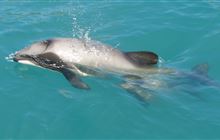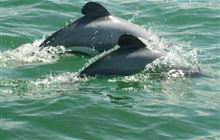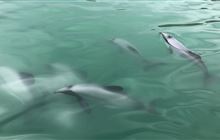Report sightings of Māui and Hector’s dolphin
Introduction
Look out for Māui and Hector’s dolphins around report any sightings immediately.
Māui and Hector's dolphins are the only dolphins in New Zealand with rounded fins that look like Mickey Mouse’s ear.
Tell us when you see a Māui or Hector’s dolphin
If you think you’ve seen a Māui or Hector’s dolphin anywhere in New Zealand, report it using one of these options:
- Use the marine mammals sighting form.
- Call our emergency hotline 0800 DOC HOT (0800 362 468)
Areas of high priority
All sightings of Māui or Hector’s dolphins are valuable, however we are especially interested in sightings in the following areas:
North Island
- the west coast north of Kaipara harbour and south of Awakino River (down to Wellington)
- inside any harbour past the entrances
- offshore 7nm
- entire south and east coast
South Island
- top of the South (excluding Queen Charlotte Sound and Golden Bay)
- the south-east corner from St Kilda, Dunedin, to Purseyger Point in Southland (excluding Te Wae Wae Bay).
Map of areas to report sightings (PDF, 2,458K)
If your sighting is in this area, we may contact you to verify your sighting. This information can help us in our attempts to find the dolphins and maybe collect a small tissue sample for DNA analysis, particularly in the North Island priority areas.
Find out more about our validation system on the Māui dolphin sightings page.
Why these areas?
Due to your ongoing efforts to report sightings of Māui and Hector’s dolphins, we are now confident in how the dolphins use some of their core habitat, such as Queen Charlotte Sound and the coast off west Auckland. We are still learning how the dolphins use some other parts of New Zealand's coastline which is where our areas of high priority are and where we are continuing to validate sightings.
What we want to know
Record and send in as much information as possible:
- the date, time and location – ideally GPS coordinates
- the number of dolphins and their estimated size
- take and include photographs or video whenever possible.
Information from sightings
Sightings inform where dolphins need protection
We need people to report sightings of Māui and Hector’s dolphin from the beach or on the water. This information helps to better understand where they live and therefore where they need protection. Sightings made by the public in the past have helped to inform where protected areas should be located.
Details are important
The more information you can provide with a sighting, the more reliable and useful it will be. If dolphin sightings are used for scientific purposes or for making new laws for conservation, they have to be checked carefully and confirmed as legitimate, this is why your contact details are required. A detailed sighting with photos or video provides the best evidence.
Reports of dead dolphins are valuable
Reports of dead Hector’s or Māui dolphin are also very important. The animals could be dead on a beach or floating at sea, and the sooner you can make the report, the better. While it can be upsetting, detailed reports and photographs of dead animals provide opportunities to collect the dolphin for a post-mortem examination that can help understand why the animal died. This contributes to better knowledge about the threats they face. The sooner this occurs after death, the more information we can gather.
DNA tests can identify individual dolphins
The results of DNA tests using tissue samples can be used to find out if a dolphin is Hector’s or Maui and if the individual dolphin has been sighted before. This provides important information about where dolphins travel.
Database of all Māui and Hector’s dolphin sightings
All sightings of Māui and Hector’s dolphins from 1970 to today are recorded in a database. The information is publicly available and updated about every 3 months.
Database of all Māui and Hector’s dolphin sightings.
Data on Māui and Hector’s dolphin incidents, e.g. stranded and beach cast dolphins, are also recorded and made available publicly, including the results of any post-mortems.



